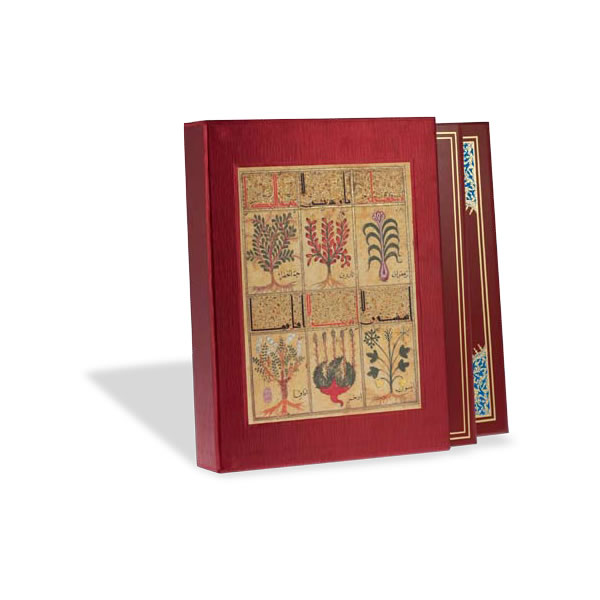Kitâb al-Diryâq
Arab description of an ancient medicinal compound
This fascinating Arab manuscript, which we are presenting in facsimile as a collector’s item, describes theriac, the ancient medicinal compound that was initially used as a specific cure for bites given by poisonous snakes and wild animals (in ancient Greek, thèrion) and which later became widely used as a panacea. It originated in Graeco-Roman antiquity and its popularity was furthered in the Islamic world, giving rise to a vast literature on the subject.
Kitâb al-Diryâq, work of Muhammad ibn Abi al-Fath, dated 1198, is the earliest and most impressive of these treatises, and was probably produced for a very special patron of the arts who wished to know more of the medicine, but also to gaze on the beautiful coloured illustrations: each of the 72 illuminated and gilded pages is a valuable work of art redolent of the fascination of the Oriental world.

This treatise is called the Paris Kitâb al- Diryâq (or Thériaque de Paris) as it is conserved in the Bibliothèque Nationale in Paris (arabe 2964) and in order to distinguish it from other copies of this popular manuscript.
The growing popularity of theriac in Europe was partly due to the influence exercised by Latin translations of Arab treatises and to the development of trade in the Mediterranean: rare and unknown ingredients such as aromatizing “spices” and medicinal drugs were included in the composition of this medicine.
But the Kitâb al-Diryâq is not only a medical treatise: it is also an engaging series of tales and anecdotes about the nine Greek physicians of antiquity who contributed to the development of the medicine, like Galen or Andromachus.
The work that has been handed down to us, written in ancient Arabic and with notes in Persian, consists of 36 sheets (72 pages) embellished with magnificent miniatures featuring traditional Arabizing motifs that only in a few cases have lost their details and brightness of colour.
The work and the characteristics of the facsimile
The introductory pages, which feature decorations and drawings, are devoted to the general contents and precede the two amazing pages of the frontispiece dedicated to the moon and its astrological and magical myths.
The calligraphic pages that follow are individual works of art in which the Kufic script is also used as a decorative feature, portraying the nine medical scholars (Andromachus the Elder, Heraclides, Philagrius, Proclus, Pythagoras, Marinus, Magnus of Mesa, Andromachus the Younger and Galen), each with his own theriac recipe, and four anecdotes relating to Andromachus the Elder, Heraclides, Philagrius and Proclus.
The long presentation of the categories of poisonous snakes and “viper esh” is linked to Andromachus the Younger.
The following twelve pages are dedicated to the illustration of the plants used in the preparation of theriac: rocket, liquorice, cardamom, opium, white pepper, incense, capers, acacia, valerian, black pepper, garlic and wild leek.
The manuscript concludes with eleven pharmaceutical recipes.
Technical characteristics of the facsimile:
- format 28.5 x 37 cm
- 36 leaves
- Miniatures engraved with satinized gold foil;
- Flyleaves 4/4 + offset gold, on 200g Munken Pure paper;
- Punched pages with manual punching of 3 inserts;
- Gilt edges, perfected by hand, on three sides;
- Hard cover binding in Cabra leather with gold and turquoise foil embossed;
- Run of 999 numbered and certified copies;
- Language: Arabic.
Commentary volume by expert Araists in 6 languages:
The critical essay to the facsimile
The comments on the manuscript, translated in six languages, are written by five expert Arabists who explain everything there is to know on the subject:
Jaclynne Kerner, a historian of Oriental art at California State University Long Beach, presents A Descriptive Reconstruction and a Classification of the Paris Kitâb al- Diryâq, describing the subject of each individual page.
Marie Geneviève Guesdon, a bibliologist at the Bibliothèque Nationale de France, gives an accurate History of the Manuscript and Codicological Presentation.
In his An Essay in Interpretation, Oleg Grabar, a professor of Islamic art at the universities of Princeton and Harvard, places the work in its historical and literary contexts and carries out an artistic analysis of the decorative work and illustrations.
Françoise Micheau, a lecturer in the Medieval History of Islamic Countries at the Sorbonne, expounds on the use of the medicine in the Graeco-Roman and Arab worlds, linking it with its use in the West, in her essay The Medical Purpose of the Book of Theriac.
Anne Caiozzo, an Arabist at the Université Paris-Diderot, dedicates her monograph The Three States of the Moon to an analysis of the superb title page, describing with fervour the magical and astrological myths and interpretations linked to this celestial body in the Arab world.


 No products in the cart.
No products in the cart. 
